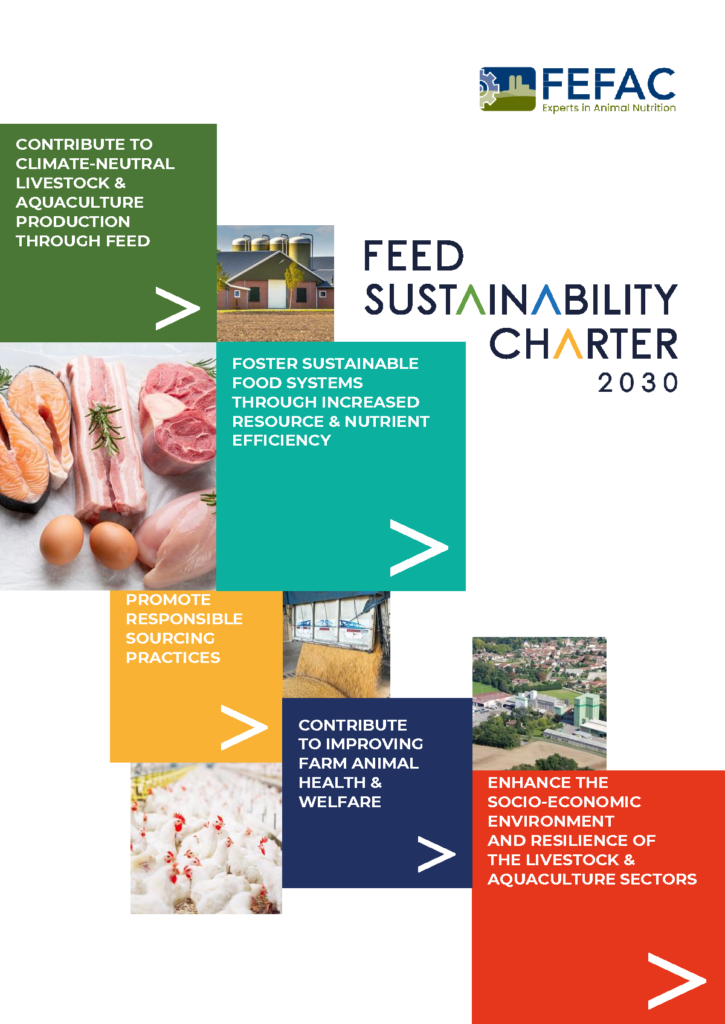Sustainability a priority for the animal feed sector

In September 2020 the European Feed Manufacturers’ Federation FEFAC published a Feed Sustainability Charter 2030. The 2nd Progress Report was published in September 2022. Highlighting five ambitions for more sustainable feed production, the charter provides an overview of how the European Feed Industry can contribute to more sustainable livestock and aquaculture value chains.
The ambitions include the contribution to climate-neutral livestock and aquaculture production through feed, fostering sustainable food systems through increased resource and nutrient efficiency, promoting responsible sourcing practices, improving farm animal health and welfare, and enhancing the socio-economic environment and resilience of the livestock and aquaculture sectors.
It has long been recognised that good formulation of animal feed is essential for reducing environmental impacts in the livestock sector. But what else is really known about what goes into producing feed?
A key fact that is perhaps not so well known is that in the EU, 96% of animal feed ingredients are “non-food grade” so not suitable for human consumption. The claim that livestock and people are ‘in competition’ for food is a common criticism which is a far from the reality. In fact, in 2017 FAO reported that at a global level 86% of what livestock eats is effectively not food that humans could have eaten.
And FEFAC goes even further into the distinction. Rather than considering what feed is “human edible” or not, FEFAC looked at whether feed is of a “food grade” nature, meaning designed primarily for the use as food and subsequently redirected to animal feed. It is a common misunderstanding that when the feed industry speaks, for example, of maize used in feed, this would mean sweetcorn. But this is not the case. People would not want to eat the cereals used in feed.
Cereal varieties grown for animal feed do not usually meet the quality requirements needed to produce human food, such as bread, beer and pasta. A significant share of cereals used in feed is downgraded from food to feed grade status because they did not meet the requirements. For this reason, from an economic point of view, feed production is never in direct competition with human consumption, hence the significantly lower quotations on the feed market. In that sense, animal feed use of the cereals will never drive shortages in the food market.
Moreover, when a feed ingredient that is food grade is sold to a feed operator, this usually results from surpluses for which demand from the human consumption market could no longer be accommodated. FEFAC’s analysis is fundamental, as it finds that practically none of the feed used by compound feed manufacturers can be considered food grade. So in essence, such use of non-food grade or surplus ingredients not only serves to feed animals efficiently, it also helps to avoid food waste.
The European feed sector also addresses other issues, such as the accurate measurement of the impact of innovative feed ingredients and the feeding strategies to reduce the methane and ammonia emissions based on feed digestion at the livestock farm level. According to the 2030 Climate Target Plan Impact Assessment in the Commission’s Methane Reduction Strategy, the EU plans to reduce methane emissions by 35–37% by 2030. Livestock can help, as cattle farming shows constant progress in methane emissions reduction. And reviewing feed composition and adding several strategic ingredients can significantly reduce emissions from animal digestion.
Animal nutrition is also a key element for reducing the need for antibiotics and enhancing farm animal health and welfare. Antibiotics in European livestock farming have steadily declined over the past decade (-43% from 2011 to 2020). ESVAC also reported that in the EU, the ‘in-feed inclusion’ of antibiotics via medicated feed was reduced by 51% between 2011-2018. These results have been achieved thanks to the best hygiene practices, vaccination and developments in animal nutrition as a preventative measure.
The use of alternative raw materials and feed additives help protect animal welfare and reduce the need for veterinary treatments. Current feeding regimes aimed at improving gut health and microbiome management have also shown excellent results for animal robustness, and for coping better with stress factors and pathogens. For this reason, animal nutrition solutions will play a central role as a preventative measure to slow development of antimicrobial resistance (AMR).

As the FEFAC Feed Sustainability Charter uses the year 2030 as the target, FEFAC will produce annual progress reports covering the key actions and activities in relation to the Charter in the preceding year. As mentioned above, the 2nd Progress Report was published in September 2022 and points to the key importance of including resilience and competitiveness as part of sustainable livestock production.
What is clear is that sustainable feed production is key to ensuring the success and resilience of the livestock sector as well as the feed and food industry!